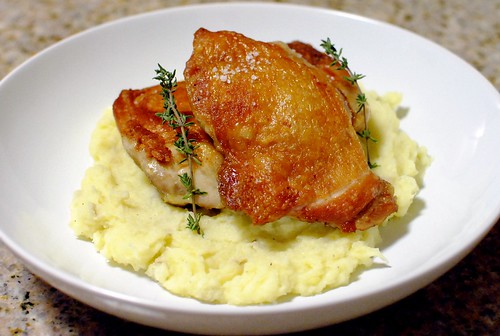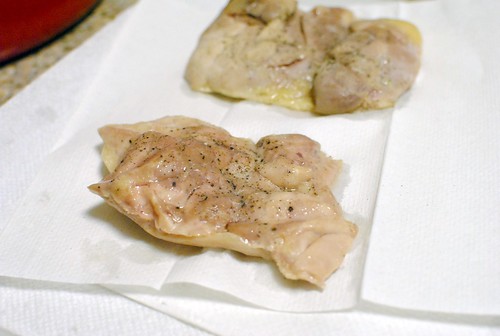Sous Vide Chicken Thighs
Dining date: 3/11/12
While browsing the web for recipes in which to use my sous vide machine, I came across one that struck me immediately. It’s Michael Voltaggio’s recipe for crispy chicken thighs, posted on the Williams-Sonoma database. It’s very similar to a recipe I’ve prepared a number of times that includes brining chicken thighs in a thyme-based brine, letting it air dry in the refrigerator until its completely dry, and finally searing them up in a pan, basting with butter and herbs. Voltaggio’s recipe would be different mainly in that it involved a sous vide application, ensuring very precise and even cooking. Plus, I’ve always found it fun (and more trustworthy) to experiment with recipes from chefs whose food I’ve actually tried and enjoyed (see ink.).
The difference sous vide technique makes to chicken thighs isn’t quite as apparent as say, chicken breast, due to the fact that there’s a larger margin of error when cooking dark meat. When cooking dark meat, my fear is always towards undercooking rather an overcooking, so I tend to cook it a little bit past the point of doneness just to be sure. Cooking the thighs sous vide would help alleviate that, plus it would just be a fun way to continue experimenting with the technique.
The first step was a brine. Voltaggio’s recipe doesn’t include a brine and I’m not sure if he was just trying to keep it simple or if it’s just unnecessary (thighs have a ton of fat/flavor on their own). I had time, so I decided to brine half of my chicken overnight and leave the other half as is. Keeping it simple and mirroring the ingredients of the recipe, my brine consisted of salt, sugar, thyme, and garlic.
The verbatim recipe is below, from the Williams-Sonoma website:
Ingredients:
6 boneless, skin-on chicken thighs
Salt and freshly ground pepper, to taste
2 garlic cloves, lightly smashed with a knife
2 or 3 fresh thyme sprigs
2 Tbs. unsalted butter
2 Tbs. canola oil, plus more as needed
Directions:
Prepare a sous vide immersion circulator for use according to the manufacturer’s instructions. Preheat the water to 150°F, 30 minutes to 1 hour.
Season the underside of the chicken thighs with salt and pepper. Place the thighs, skin side down, into a vacuum-sealable bag, making sure they lie flat. Add the garlic, thyme and butter to the bag. Using a vacuum sealer, vacuum and seal the bag tight according to the manufacturer’s instructions; be sure you have a smooth, airtight seal. Carefully place the bag into the circulating water and cook for 1 to 1 1/2 hours.
Have ready a large bowl of ice water. Remove the thighs from the circulating water and place the bag into the ice water for 20 minutes. If serving the chicken that day, place the bag on a baking sheet and refrigerate until ready to sear the thighs. If serving the chicken the next day, place the bag, with the thighs skin side down, on a baking sheet. Place another baking sheet on top and weight it down with a heavy fry pan. Refrigerate overnight.
Just before serving, remove the thighs from the bag and pat dry with paper towels. In a large fry pan over medium heat, warm 1 to 2 Tbs. oil. Working in batches, place the thighs, skin side down, in the pan and cook until golden brown and crispy, 8 to 10 minutes. Turn the thighs over and cook until warmed through, about 2 minutes more. Transfer the thighs to a plate and cover loosely with aluminum foil. Repeat with the remaining thighs, adding more oil to the pan as needed. Serve immediately. Serves 4 to 6.
I followed each step as precisely as I could:, first by vacuum sealing my chicken (note the “discoloration” of half of the pieces due to the brine).
After leaving it in the water bath for about 90 minutes, I took the chicken out. Since the water bath was at 150F, this chicken was not yet fully cooked – the final sear would complete the process. As with most items cooked sous vide, it didn’t look very appetizing, basically resembling a boiled/poached piece of chicken. I dried them out as much as possible, knowing this would be key to getting a crispy skin.
Once crisped up, I placed the chicken thighs atop Yukon Gold mashed potatoes, sprinkled some sea salt, and garnished with a sprig of thyme (just like the picture in the recipe!). I was pretty happy with the results and kind of surprised I was able to get the skin so evenly crispy. I attributed it to ensuring the skin was dry before putting it into the pan, as well as making sure the thighs were as flat as possible throughout the process (ensuring even cooking).
The meat was delicious, very juicy and exuding the thyme perfume I was aiming for. Was there a significant difference between the brined and unbrined chicken? No I don’t think so; in fact, I couldn’t really tell the difference. Compared to my old method, I found the meat to have a more uniform texture and temperature…and I knew it was going to be cooked through.
I thought this was quick and easy enough as a weeknight meal; even better, a large batch can be prepared on the weekend and left in the refrigerator to be seared during the week. I’ll definitely be making this again.





Gorgeous, Darin! I’m not a huge chicken fan, but your thighs look BOMB! I’d eat it 😉
Thanks Cathy!
I’m confused. At 150F it would take 3 minutes for the chicken to pasteurize. After 90 minutes it should be very well cooked, unless you meant cooked as in ready to serve from looks and searing purposes.
I think you could definitely take it out earlier – the recipe is a little conservative on the timing. I would probably keep it at least an hour on the safe side – your 3 minute calculation may begin once the chicken actually reaches 150 degrees (which will take some time).